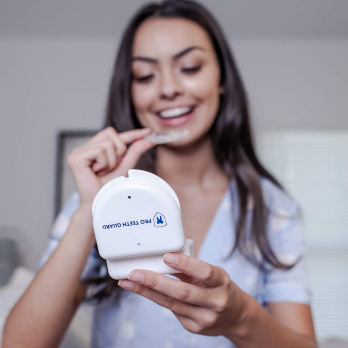Can Mewing Help With Bruxism
13th Mar 2025

The dentist told you that you grind your teeth, and you read online that mewing might help. If you’ve had similar thoughts, you’re not alone. Bruxism, or teeth grinding, is a common issue, and many wonder if mewing can provide relief.
The current evidence suggests that mewing doesn’t prevent or treat bruxism. While it may improve jaw posture, there’s no strong research supporting its effectiveness for teeth grinding.
In this article, we’ll look at the link between mewing and bruxism, explore any potential risks, and share proven solutions for managing bruxism effectively.
What is Mewing?
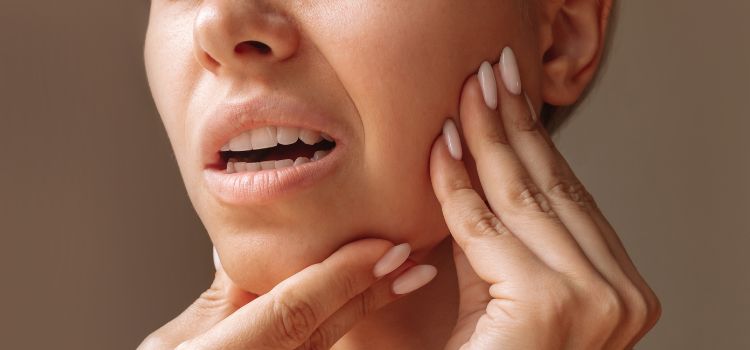
Mewing is a technique designed to improve jaw and facial structure by practicing specific oral posture. Named after Mike and John Mew, the British orthodontists who developed it, Mewing is part of a broader practice called "orthotropics."
The method involves placing your tongue on the roof of your mouth and applying gentle pressure to potentially reshape the jaw over time. (see Dr. Mike Mew's Ultimate Mewing Guide) However, there isn’t any solid scientific evidence to support the effectiveness of orthotropics.
In an article titled "Mewing: Social Media's Alternative to Orthognathic Surgery?" discusses the rise of "Mewing," a technique popularized on social media platforms like Instagram and YouTube. Advocates claim that Mewing can serve as an alternative to traditional orthognathic surgery and orthodontic treatments.
Sources: McKeown, Kruger, & Tennant, 2019 , Mewing (Orthotropics)," n.d.
Note: The oral and maxillofacial surgery community is encouraged to be aware of this trend, as it may influence patient perceptions and decisions regarding conventional treatments. The public needs to be made aware that it is not based on sound scientific evidence that would make it a viable alternative treatment to orthognathic surgery.
Source: Mewing: Social Media's Alternative to Orthognathic Surgery?
What Are the Potential Risks of Mewing?
Mewing is generally considered safe when practiced correctly, but like any technique, it’s not without potential risks. Here are some things to keep in mind:
Jaw Strain or Discomfort
If you push your tongue too hard against the roof of your mouth or clench your teeth, it can cause strain in your jaw muscles. Over time, this may lead to discomfort or even tension headaches.
Worsening Symptoms
For people already experiencing jaw issues, such as temporomandibular joint (TMJ) pain, practicing mewing incorrectly could make these problems worse.
Unrealistic Expectations
Many people try mewing with the hope of fixing conditions like bruxism or dramatically changing their facial structure. When these results don’t appear, it can lead to frustration or delay in seeking proven treatments.
Incorrect Techniques
Without proper guidance, it’s easy to make mistakes, like overly forceful tongue placement or poor jaw posture, which can do more harm than good.
Note: Expert Orthodontics from Austin, TX shed light on the potential dental health risks linked to mewing. Source: What is Mewing and is it bad for your teeth?
Can Mewing Help with Bruxism?
Mewing is often talked about as a way to improve jaw posture and alignment, but can it actually help with bruxism? The short answer is: not really.
While proper tongue posture may have benefits for overall oral health, there’s no scientific evidence showing that mewing can prevent or treat teeth grinding. Bruxism is often caused by things like stress, sleep disorders, or jaw alignment issues, and mewing doesn’t directly address these root causes.
Related Articles:
What We Currently Know About Mewing
What Research Says
There isn’t much scientific evidence showing that mewing can help with bruxism. Some experts believe improving jaw posture may have benefits for overall oral health, but there’s no proof that mewing can stop teeth grinding. Most of the claims about mewing are based on personal stories rather than reliable studies.
Mewing as a possible cause of salivary gland cysts
A 16-year-old boy practiced mewing excessively, hoping to enhance his facial aesthetics, but developed a painless swelling under his chin over three months. Doctors found a cyst near his salivary glands (Salivary Gland Dysfunction), which they believe may have been linked to the pressure created by excessive mewing.
This is the first reported case of a possible connection between excessive mewing and salivary gland dysfunction, though the link remains unproven. The findings suggest that overdoing the exercise might increase pressure in the glands, potentially leading to issues like cyst formation.
Orthodontist Mike Mew Faces Misconduct Allegations Over Risky Treatments
Dr. Mike Mew, a British orthodontist known for promoting "mewing" techniques to alter jawlines, faced a misconduct hearing by the General Dental Council (GDC) in November 2022. The GDC alleged that Dr. Mew’s treatments for young children, which included the use of headgear and expansion appliances, posed potential risks of harm.
Additionally, he was accused of making derogatory remarks about traditional orthodontic practices. The hearing highlighted concerns within the dental community regarding the safety and effectiveness of Dr. Mew’s methods, which have gained significant attention on social media platforms like TikTok (The Guardian, 2022).
Mike Mew was removed from the British Orthodontic Society. Source: Orthotropics
So, Is Mewing Safe to Practice?

While mewing is unlikely to cause immediate harm, it also doesn’t deliver the dramatic results some claim. For adults, mewing is highly unlikely to reshape the face, teeth, or jaw, as bone growth has already stopped.
Relying on mewing as a solution could lead to false hope and delay proper treatment for real dental or jaw issues.
Note: The AAO advises against trying to move teeth or align your jaw on your own without proper supervision, as it’s unlikely to give you the results you want. Source: Is mewing bad for you?
Understanding Bruxism
Bruxism, or teeth grinding, is a condition that many people experience without even knowing it. It can happen when you’re asleep (sleep bruxism) or awake (awake bruxism).
Signs of Bruxism
- Grinding or clenching your teeth (sometimes loud enough to wake someone nearby).
- Teeth that are worn down, chipped, or cracked.
- Soreness or stiffness in your jaw.
- Headaches, especially in the morning.
- Teeth that feel extra sensitive.
What Causes Bruxism?
There are a few common reasons why people grind their teeth:
Stress or Worry: Feeling stressed or anxious often leads to clenching or grinding.
Sleep Problems: Conditions like sleep apnea can trigger bruxism.
Teeth Alignment Issues: If your teeth or jaw aren’t properly aligned, it can cause tension.
Lifestyle Habits: Things like smoking, caffeine, or alcohol can make grinding worse.
While mewing is sometimes mentioned as a way to help with bruxism, there’s no solid proof that it works. Instead, understanding what’s causing your grinding is the first step to finding the right solution.
6 Proven Ways to Treat Bruxism
If mewing isn’t the solution for bruxism, what options do you have? Luckily, there are several proven ways to manage teeth grinding and protect your teeth.
1. Night Guards
Custom-fit night guards are one of the most effective ways to prevent damage from bruxism. They create a protective barrier between your teeth, reducing the pressure and wear caused by grinding.
2. Stress Management
Since stress is a major trigger for bruxism, finding ways to relax can help. Try techniques like meditation, yoga, or deep breathing exercises to lower stress levels.
3. Treating Sleep Disorders
If your bruxism is linked to a sleep disorder like sleep apnea, addressing that condition can significantly reduce grinding. Speak to your doctor about a sleep study or potential treatments.
4. Jaw Exercises or Physical Therapy
Working with a dentist or physical therapist to improve jaw mobility and reduce tension can be helpful for some people.
5. Limiting Triggering Habits
Cutting back on caffeine, alcohol, or smoking can decrease the severity of grinding.
6. Dental or Orthodontic Treatments
If your bruxism is caused by misaligned teeth or jaw issues, dental treatments like braces, aligners, or reconstructive work may help.
Bruxism can often feel overwhelming, but there are many effective ways to manage it. If you’re unsure where to start, consulting your dentist is a great first step. They can guide you toward the best solution for your specific situation.
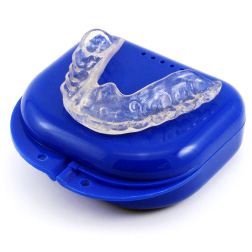
- Most Popular
- Hard Outside, Soft Inside
- 2MM Thick
- Moderate / Heavy
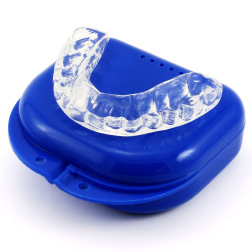
- Most Durable
- Hard Materials
- 1.5MM Thick
- Heavy / Severe
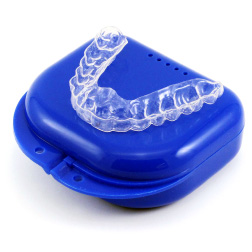
- For Day Time Use
- Thin, Barely Visible
- 1MM Thick
- Light / Moderate

- For Clenching
- Flexible & Soft
- 1.5MM Thick
- Light / Moderate
Final Thoughts
Mewing is often "promoted" as a way to improve jaw posture, but it is not proven or reliable. Relying on mewing can give false hope and may delay proper treatment, allowing teeth grinding to cause more damage over time.
Bruxism requires real, evidence-based solutions like custom night guards, stress management, and professional dental care to address the root causes effectively. Instead of risking your oral health with unproven techniques, consult a dentist for expert guidance.
To protect your teeth and manage bruxism effectively, check out Pro Teeth Guard’s custom night guards. They’re an easy and trusted way to reduce grinding and keep your smile safe. Visit Pro Teeth Guard to find the right option for you!

- Most Popular
- Hard Outside, Soft Inside
- 2MM Thick
- Moderate / Heavy

- Most Durable
- Hard Materials
- 1.5MM Thick
- Heavy / Severe

- For Day Time Use
- Thin, Barely Visible
- 1MM Thick
- Light / Moderate

- For Clenching
- Flexible & Soft
- 1.5MM Thick
- Light / Moderate
